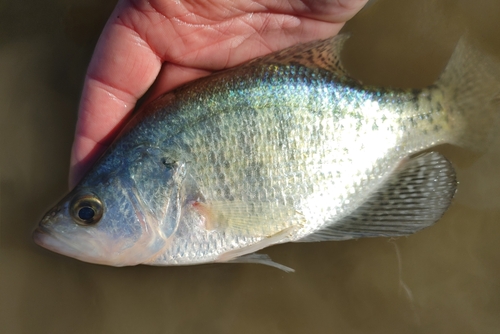
White Crappie
The Bluefin Tuna (Thunnus thynnus, Thunnus orientalis, Thunnus maccoyii) are among the most remarkable fish in the ocean. Known for their incredible size, speed, and migratory habits, they are apex predators that play a crucial role in marine ecosystems. They are also a highly prized food fish, leading to significant conservation challenges.
4 9 years
Lifespan
18 - 53 cm
Length
Least Concern
Conservation Status
5 km/h
Swimming speed
Carnivorous, Insectivorous
Diet
Local Migration
Migration
Appearance Overview
The Bluefin Tuna is renowned for its large, streamlined body, built for speed and endurance in the open ocean.
Color
Dark metallic blue above, silvery white below
Body Shape
Torpedo-shaped, with a crescent-shaped tail
Fins
Two dorsal fins, the first depressible into a groove; small finlets running from the second dorsal and anal fins to the tail
Length
Up to 13 feet (4 meters), commonly around 6.5 feet (2 meters)
Weight
Up to 2,000 lbs (907 kg), commonly around 550 lbs (250 kg)
Diet
Carnivorous, feeding on a variety of fish, squid, eels, and crustaceans.
Feeding Behavior
Highly active predators, Bluefin Tuna use their speed and agility to hunt, often feeding near the surface but capable of deep dives.
Social Behavior
Known to form schools, sometimes segregated by size; they are highly migratory, traveling vast distances across oceans.
Commercial Relevance
Extremely high value, especially in sushi and sashimi markets, where its fatty flesh is considered a delicacy.
Conservation measures
Subject to international fishing quotas, marine protected areas, and ongoing research to improve stock management.
Status
Varies by species; Atlantic Bluefin is considered Endangered, while Pacific Bluefin is Vulnerable.
Threats
Overfishing is the primary threat, driven by high demand for sushi; climate change and habitat degradation also pose risks.
Habitat Distribution
Depth Range
0-3,300 feet (0-1,000 meters), though they are commonly found in shallower waters.
Geographic Range
Atlantic, Pacific, and Indian Oceans; Mediterranean Sea.
Preferred Environment
Primarily pelagic, inhabiting temperate and subtropical waters; they are capable of thriving in a wide range of temperatures.
Reproduction and Life Cycle
Breeding Habits
Spawning occurs in specific areas, such as the Gulf of Mexico and the Mediterranean Sea for Atlantic Bluefin, with timing varying by region.
Development Stages
Larvae hatch and develop in warm, plankton-rich waters. Juveniles grow rapidly, reaching considerable size within their first year.
Fecundity
Highly fecund; a single female can produce millions of eggs per spawning season, releasing them into the water for external fertilization.
Maturity Age
Varies by species; Atlantic Bluefin typically mature between 4-8 years, while Pacific Bluefin may mature slightly earlier.
Faqs about White Crappie
How fast can Bluefin Tuna swim?
Bluefin Tuna are among the fastest fish in the ocean, capable of bursts of speed up to 43 mph (70 km/h).
What is the lifespan of a Bluefin Tuna?
Bluefin Tuna can live up to 40 years, though this varies by species and region.
Are Bluefin Tuna warm-blooded?
Yes, Bluefin Tuna are warm-blooded, which allows them to maintain a higher body temperature than the surrounding water, aiding in muscle efficiency.
Do Bluefin Tuna migrate?
Bluefin Tuna undertake extensive migrations for feeding and spawning, often crossing entire oceans.
Why is Bluefin Tuna so popular in sushi?
The high fat content of Bluefin Tuna, particularly in the belly (toro), is highly prized for its rich flavor and texture in sushi.
How deep can Bluefin Tuna dive?
Bluefin tuna can dive to depths exceeding 3,000 feet (900 meters), though they frequently inhabit shallower waters.
Which organizations are involved in Bluefin Tuna conservation?
Several organizations, including the International Commission for the Conservation of Atlantic Tunas (ICCAT) and the Western and Central Pacific Fisheries Commission (WCPFC), manage Bluefin Tuna fisheries.
How can consumers help Bluefin Tuna conservation?
Consumers can support sustainable Bluefin Tuna populations by choosing seafood from certified sustainable sources and avoiding consumption of overfished species.
Copyright @ Nature Style Limited. All Rights Reserved.
 English
English